A house structure remaining its quadrant with a right-angled wall slot, a hollowed hearth containing both red-hot stones and burned soil, and nine pits, some of which must have served for upright postholes. It might well have been a pit-dwelling of a squared shape with its side 5m. Another house structure of the same period was found, 30m apart from here to the west.
| HOME | Exhibition Top | CESCHI | CESCHI(Faculty) | Kyoto University |
| Features / Structure : Jomon-Yayoi | ||||||
| Jomon | ||||||
| Pit-dwelling | Cemetery | Funerary urn | Prehistoric woodland | Storage pit | Burial | |
| Yayoi | ||||||
| Paddy field 1 | Paddy field 2 | Debris flow | V-shaped ditch | |||
| ⇒ Next (Ancient and Medieval) |
| Pit-dwelling | |
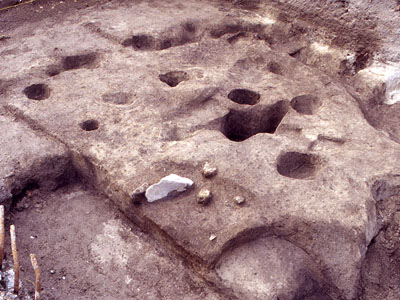
|
Age |
Middle Jomon period |
|
| Location | |
North Campus |
|
| Caption | |
|
|
|
| ⇒ Return to Top | |
| Cemetery | |
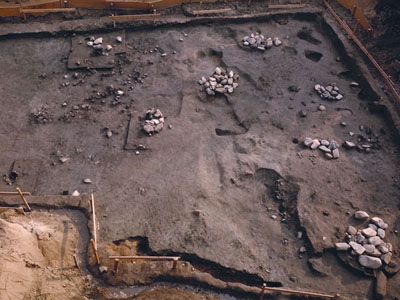
|
Age |
Late Jomon period |
|
| Location | |
North Campus |
|
| Caption | |
|
Eight stone-arranged graves, one of which had a complete jaw underneath the stones. Two types of stone-arrangement are recognised; of about thirty skull-sized stones arranged to make a rounded plan, and of around ten skull-sized stones paved randomly. Those eight graves, which have been exhibited at the University Botanical Garden adjacent to the locale, together with six funerary urns close to them constituted a cemetery of the early Late Jomon. |
|
| ⇒ Return to Top | |
| Funerary urn | |
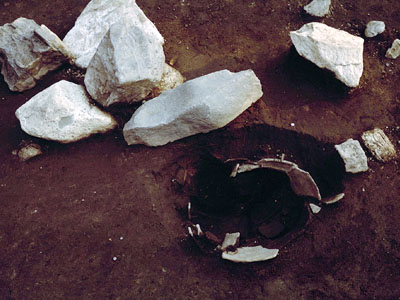
|
Age |
Late Jomon period |
|
| Location | |
North Campus |
|
| Caption | |
|
A funerary urn. The cemetery, as mentioned above, had six funerary urns. Two of them seem to have been placed on the earth while others were embedded into the ground. These pottery graves were followed by the stone-arranged graves, from the point of view of typological studies on pottery, as well as the observation on one urn which had partly been destroyed by stone-arranging activity. |
|
| ⇒ Return to Top | |
| Prehistoric woodland | |
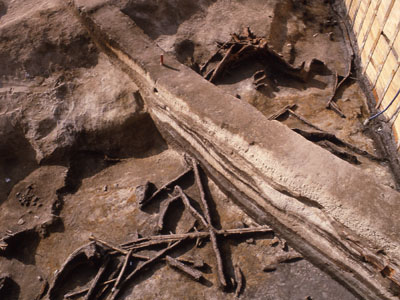
|
Age |
Final Jomon period |
|
| Location | |
North Campus |
|
| Caption | |
|
Well-preserved fallen branches and twigs of a mixed forest, with alternately depositing layers of sand and clay or peat; all assigned to Final Jomon. From these layers appeared a wide variety of natural remains with an enormous number of footprints of both human beings and animals. Paleobotany, palynology, and sedimentology contribute to the reconstruction of micro-ecology as a mixed forest within the Shirakawa fan area of reticulated canals during Final Jomon Period. |
|
| ⇒ Return to Top | |
| Storage pit | |
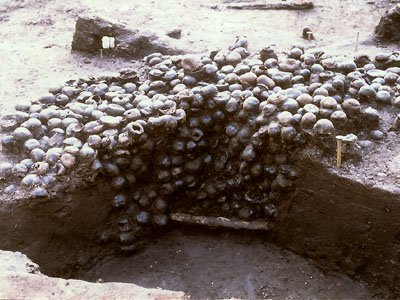
|
Age |
Final Jomon period |
|
| Location | |
North Campus |
|
| Caption | |
|
A storage pit filled with about 2,000 pieces of Japanese horse chestnut. This feature, measuring 60cm by 45cm of a elliptic shape with a depth of 25cm, was located on the gentle slope of the bank of a stream. All pieces had been shelled, in contrast to a considerable number of fallen ones with nutshells that were found 20m downstream from the pit. Waterlogged locating of a storage pit is one of the typical food-processing strategies during Jomon period in western Japan. |
|
| ⇒ Return to Top | |
| Burial | |
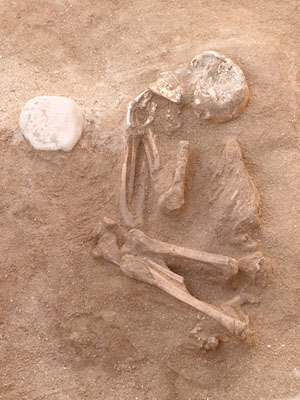
|
Age |
Final Jomon Period |
|
| Location | |
Seto Marine Biological Laboratory |
|
| Caption | |
|
An inhumation of a crouched adult woman (20-40 years old). She was laid on her right side, north to south, with her head to the north. She had experienced teeth extractions. There are, as grave goods, a large stone at the forward of the neck, and a cowrie around the femora; the species of that shell has traditionally been believed in Japan as what could bring an easy delivery to a pregnant woman. |
|
| ⇒ Return to Top | |
| Paddy field 1 | |
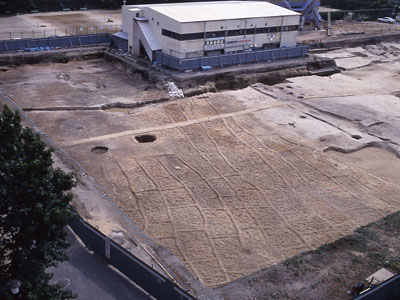
|
Age |
Early Yayoi period |
|
| Location | |
Yoshida-South Campus |
|
| Caption | |
|
Paddy field at the backed marsh of the Takano river. Two contrastive types of land using are revealed in the field. The northern half, composed of north-to-south directing small rectangular panels with gentle ridges for water-keeping (10 square-meters per panel), left their surface undulant. The southern half on the other hand, composed of east-to-west directing larger panels, let their surface smooth. The implication is that even in the early food-producing community had already achieved a calculative irrigation system. |
|
| ⇒ Return to Top | |
| Paddy field 2 | |
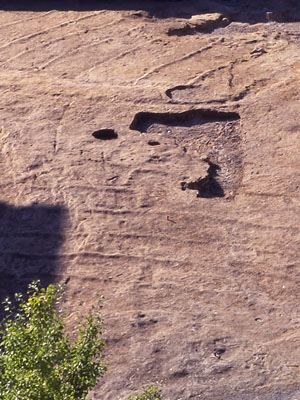
|
Age |
Early Yayoi period |
|
| Location | |
North Campus |
|
| Caption | |
|
Paddy field of small-scale cultivation. Even this narrow gentle slope could have been exploited to obtain the leveled ground for water-level maintaining, as shown by the fact that a subtle bank divides this narrow field into two paneled areas. The amount of plant-opal recovered from a number of core samples is quite small, which indicates the rice cultivation of short duration. |
|
| ⇒ Return to Top | |
| Debris flow | |
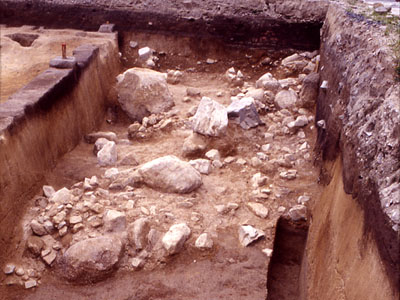
|
Age |
The end of Early Yayoi Period |
|
| Location | |
North Campus |
|
| Caption | |
|
One of the main torrents of the granite debris flow originated from the Hiei mountainous area to the east. The yellow-brown sand deposition caused by this event has been sheeted almost everywhere in and around the University Campus, occasionally containing huge rocks measuring 2m in diameter and sometimes depositing more than 2m in thickness. More than half million cubic meters of debris must have been brought to the Shirakawa fan. |
|
| ⇒ Return to Top | |
| V-shaped ditch | |
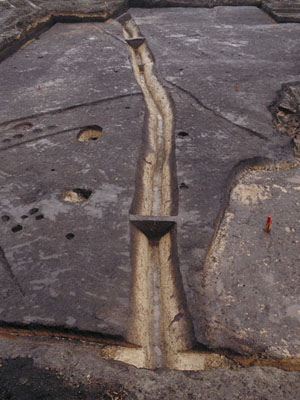
|
Age |
Middle Yayoi Period |
|
| Location | |
|
Mizuki Site
situated at Livestock Farm at Kyotanba Town |
|
| Caption | |
|
A typical V-shaped ditch of Yayoi period up to 2.5m wide,1m depth. |
|
| ⇒ Return to Top | |
| ⇒ Next (Ancient and Medieval) |
| HOME | Exhibition Top | CESCHI | CESCHI(Faculty) | Kyoto University |